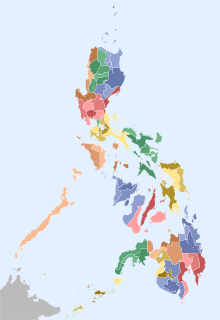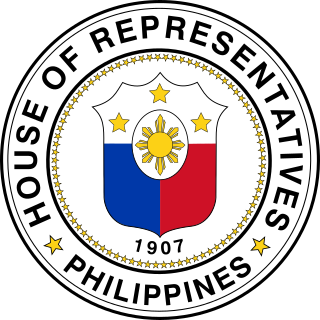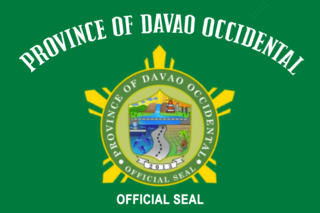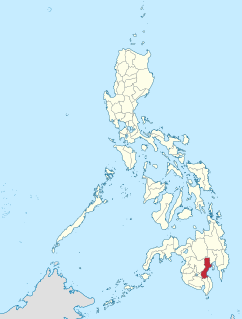Related Research Articles

In the Philippines, provinces are one of its primary political and administrative divisions. There are 81 provinces at present, which are further subdivided into component cities and municipalities. The local government units in the National Capital Region, as well as independent cities, are independent of any provincial government. Each province is governed by an elected legislature called the Sangguniang Panlalawigan and an elected governor.

The House of Representatives of the Philippines is the lower house of the Congress of the Philippines. Informally known as the Kamara, the lower house is usually called Congress, although the term collectively refers to both houses.

Davao, officially the Province of Davao, was a province in the Philippines on the island of Mindanao. The old province is coterminous with the present-day Davao Region or Region XI. It was divided into three provinces of Davao del Norte, Davao Oriental, and Davao del Sur with the passage of Philippine Republic Act No. 4867 on May 8, 1967. Two more provinces, Compostela Valley and Davao Occidental, were carved out of the territories of Davao del Norte and Davao del Sur respectively. The descendant provinces were reorganized into the current region in 2001.
The legislative districts of Agusan del Sur are the representations of the province of Agusan del Sur in the various national legislatures of the Philippines. The province is currently represented in the lower house of the Congress of the Philippines through its first and second congressional districts.
The legislative districts of Basilan are the representations of the province of Basilan in the various national legislatures of the Philippines. The province is currently represented in the lower house of the Congress of the Philippines through its lone congressional district.
The legislative districts of Davao City are the representations of the highly urbanized city of Davao in the various national legislatures of the Philippines. The city is currently represented in the lower house of the Congress of the Philippines through its first, second, and third congressional districts.
The legislative districts of Davao del Norte are the representation of the province of Davao del Norte in the various national legislatures of the Philippines. The province is currently represented in the lower house of the Congress of the Philippines through its first and second congressional districts.
The legislative districts of Davao del Sur are the representations of the province of Davao del Sur in the various national legislatures of the Philippines. The province is currently represented in the lower house of the Congress of the Philippines through its lone congressional district.
The legislative districts of Davao Oriental are the representations of the province of Davao Oriental in the various national legislatures of the Philippines. The province is currently represented in the lower house of the Congress of the Philippines through its first and second congressional districts.
The legislative district of Davao was the representation of the historical province of Davao in the various national legislatures of the Philippines until its dissolution in 1967.

Davao Occidental is the 81st and newest province in the Philippines located in the Davao Region in Mindanao. Its capital is the municipality of Malita. To the east lies the Davao Gulf. It also shares a maritime border with the Indonesian province of North Sulawesi to the south.
On October 28, 2013, residents of Davao del Sur voted in a plebiscite to approve or disapprove the creation of the then proposed province of Davao Occidental.
The legislative districts of Davao Occidental are the representations of the province of Davao Occidental in the Congress of the Philippines. The province is currently represented in the lower house of the Congress through its lone congressional district.
Davao's at-large congressional district may refer to several occasions when a provincewide at-large district was used for elections to the various Philippine national legislatures from the undivided province of Davao.
Davao del Norte's at-large congressional district is an obsolete congressional district that encompassed the entire province of Davao del Norte in the Philippines. It was represented in the House of Representatives from 1968 to 1972 and in the Regular Batasang Pambansa from 1984 to 1986. The province of Davao del Norte was created as a result of the partition of Davao in 1967 and elected its first representative provincewide at-large during the 1969 Philippine House of Representatives elections. Lorenzo S. Sarmiento who served as representative of Davao's at-large congressional district during the partition was this district's first representative. The district remained a single-member district until the dissolution of the lower house in 1972. It was later absorbed by the multi-member Region XI's at-large district for the national parliament in 1978. In 1984, provincial and city representations were restored and Davao del Norte elected three members for the regular parliament. The district was abolished following the 1987 reapportionment to establish three districts under a new constitution.

Davao del Sur's at-large congressional district is the sole congressional district of the Philippines in the province of Davao del Sur. It was originally created by the 1967 division of the old Davao province and was eliminated following the 1972 abolition of the House of Representatives. The district was restored as a plural member district for the 1984 national parliament known as the Batasang Pambansa but was reconfigured after Davao City gained its own representation. It was eliminated again following the 1987 reapportionment that created an additional district. The district's current configuration dates from 2013 when Davao del Sur lost a seat following the creation of the province of Davao Occidental covering much of its 2nd district. The district is represented in the 18th Congress by Mercedes Cagas of the Nacionalista Party (NP).
Davao City's at-large congressional district may refer to two occasions when a city-wide at-large district was used for elections to Philippine national legislatures from Davao City.
Davao del Sur's 1st congressional district is an obsolete congressional district in Davao del Sur for the House of Representatives of the Philippines from 1987 to 2016. The district encompassed seven northern local government units of the previously undivided province bordering Davao City and includes Digos, the provincial capital. It was created ahead of the 1987 Philippine House of Representatives elections following the ratification of the 1987 constitution which established two districts for the province and another three districts for Davao City. Prior to the 1987 apportionment, Davao del Sur residents elected their representatives to the national legislatures on a provincewide basis through the Davao del Sur's at-large congressional district. The district was last contested at the 2013 Philippine House of Representatives elections. Davao del Sur returned to electing its representatives at-large in 2016 after losing most of its southern territory to the province of Davao Occidental created by Republic Act No. 10360 on January 4, 2013.
Davao del Norte's 3rd congressional district is an obsolete congressional district in Davao del Norte for the House of Representatives of the Philippines from 1987 to 1998. The district encompassed six municipalities of the previously undivided province, most of which now constitute the 2nd district. It was created ahead of the 1987 Philippine House of Representatives elections following the ratification of the 1987 constitution which established three districts for Davao del Norte. Prior to the 1987 apportionment, Davao del Norte residents elected their representatives to the national legislatures on a provincewide basis through the Davao del Norte's at-large congressional district. The district was last contested at the 1995 Philippine House of Representatives elections. It was eliminated by the 1998 reapportionment after the province lost significant territory to the new province of Compostela Valley created through Republic Act No. 8740 on January 30, 1998.
Agusan del Sur's at-large congressional district is an obsolete congressional district that encompassed the entire province of Agusan del Sur in the Philippines. It was represented in the House of Representatives from 1969 to 1972, in the Regular Batasang Pambansa from 1984 to 1986, and in the restored House of Representatives from 1987 to 2010. The province of Agusan del Sur was created as a result of the partition of Agusan in 1967 and elected its first representative provincewide at-large during the 1969 Philippine House of Representatives elections. It was a short-lived district for the Third Philippine Republic Congress, having been eliminated following the dissolution of the lower house in 1972. The province was later absorbed by the multi-member Region X's at-large district for the national parliament in 1978. In 1984, provincial and city representations were restored and Agusan del Sur elected a member for the regular parliament. The district was re-established ahead of the 1987 Philippine House of Representatives elections and continued to elect representatives until Agusan del Sur was reapportioned in 2008 and which took effect in 2010.
References
- ↑ "Roster of Philippine legislators". House of Representatives of the Philippines . Retrieved February 24, 2021.
- 1 2 "The 1987 Constitution of the Republic of the Philippines". Chan Robles Virtual Law Library. Retrieved February 24, 2021.
- ↑ "Republic Act No. 10360". Official Gazette (Philippines) . Retrieved February 24, 2021.